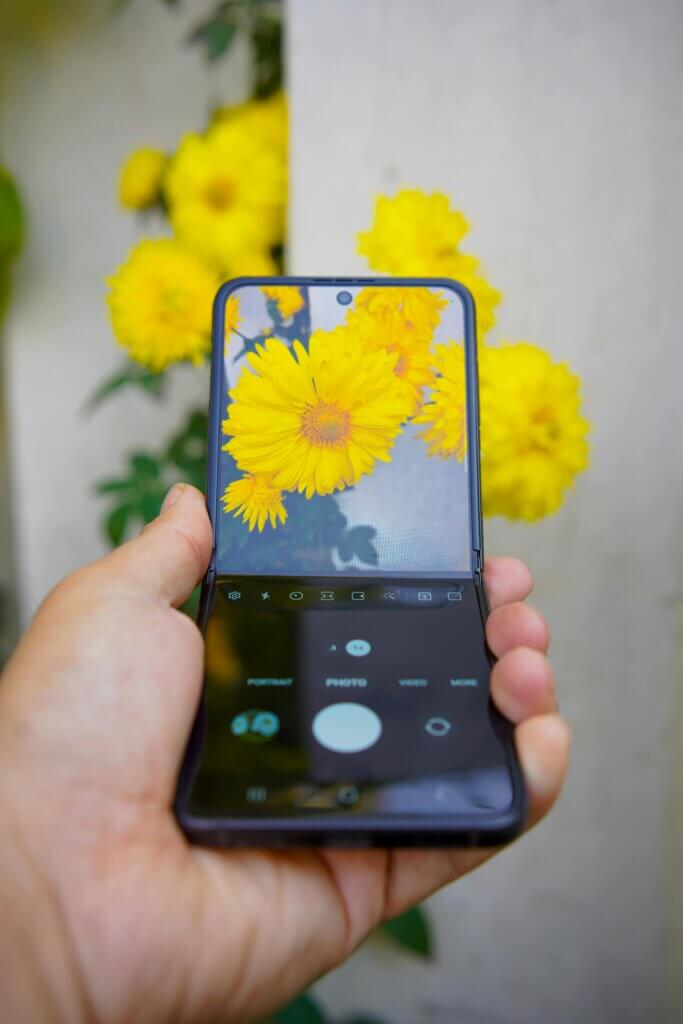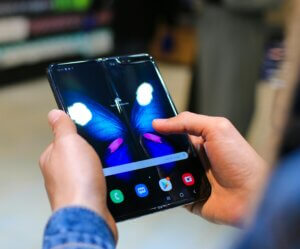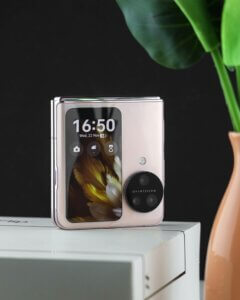Designing Apps for Foldable and Flexible Screens
October 15, 2024 - 13 minutes readAfter reading this article, you’ll:
- Grasp the current state and future potential of foldable device technology, including market projections and the impact on app development.
- Recognize the unique features and capabilities of foldable screens, such as innovative form factors and enhanced multitasking possibilities.
- Understand the key challenges and best practices for designing and developing apps optimized for foldable and flexible screen devices.

In recent years, we have seen the emergence of foldable and flexible screen smartphones and tablets. Major manufacturers like Samsung, Huawei, Oppo, and Motorola have released foldable devices featuring displays that can bend, fold, and flex.
These innovative devices present new form factors that aim to enhance user experience and productivity. According to projections, the market for foldable devices is likely to grow to over $29 billion by 2024, with over 25 million units shipped annually.
As foldable devices become more mainstream, it will be crucial for app developers to optimize their designs for these new dynamic screen sizes and modes. Apps will need to seamlessly transition between display configurations and adapt their layouts and interfaces to take advantage of the capabilities of flexible screens.
Implementing responsive, flexible UI components and utilizing foldable-specific APIs will enable more continuity and consistency across single, double, or expanded screen modes. Testing on emulators and real foldable devices will also help assess and enhance the user experience.
Overall, supporting foldable and dual-screen devices can help apps reach more users, stand out on app stores, and enable innovative new features and experiences. Adapting app design is key to fully leveraging the potential of emerging flexible display technologies.
Understanding Foldable and Flexible Screen Technology
Foldable devices represent an exciting new category of mobile devices that feature flexible display screens capable of bending, folding, and twisting. This enables innovative new form factors that enhance user experience and productivity.
There are a few types of foldable devices currently available and in development:
- Inward Fold: Display folds inwards like a book, with screen inside. Examples—Samsung Galaxy Z Fold series.
- Outward Fold: Display folds outwards, with screen on outside. Example—Huawei Mate X series.
- Dual Screen: Two separate screens connected with a hinge, can fold out into one large display. Example—Microsoft Surface Duo.
The foldable displays use flexible OLED screen technology, with advanced materials and components that enable the screen to bend repeatedly without damage. This allows for a seamless experience as the user transforms the device from one screen size/configuration to another.
Flexible screens also enable new use cases like splitting a single app across both displays or using a folded device in tent mode. Multi-tasking capabilities are also enhanced on these devices. There is great potential for app developers to optimize and innovate for dual-screen and foldable UIs.
Foldable display technology brings new possibilities for smartphones, tablets, and laptops. As these devices become more refined and capable, adapting app design to these form factors will enable more immersive and productivity-focused user experiences.
Innovative Features Enabled by Foldable Screens
Foldable devices with their dynamic screen sizes and configurations open up new possibilities for innovative app features and experiences.
Dual screens and expanded canvas allow for next-level multitasking. Users can run multiple apps simultaneously and easily share data between them, with the ability to view more information at once.
 The larger screens are also ideal for more immersive content consumption, such as widescreen video watching or digital book reading. The flexibility enables more comfortable holding positions.
The larger screens are also ideal for more immersive content consumption, such as widescreen video watching or digital book reading. The flexibility enables more comfortable holding positions.
Different foldable modes lend themselves to new interaction paradigms – tent mode for media viewing, book mode for reading, adjusted angles for gaming or typing. This expands use case scenarios.
For business/productivity apps, foldables enable power-user features like app pinning to keep content visible while multitasking or quickly referencing information from another displayed app.
Foldable’s unique form factors permit apps to deliver features not possible on traditional single-screen devices. The additional real estate and configurations lead to richer user experiences.
Opportunities for Businesses
Foldable devices present fresh opportunities for companies to deliver innovative services, gain competitive edge, and explore new revenue streams.
Innovative User Interfaces and Experiences
The adaptable screens of foldable phones and tablets allow the creation of more immersive and flexible user interfaces. Businesses can leverage additional display real estate for data visualization, creative workflows, multimedia experiences, and enhanced multitasking.
Competitive Edge
By proactively optimizing offerings for foldable devices as they gain traction, companies can differentiate themselves from competitors. Aligning with evolving consumer tech and expectations helps attract more customers.
New Revenue Streams
The advanced capabilities of foldable devices open possibilities for delivering premium, exclusive services. Companies can monetize add-ons like multi-window apps, content bundles tailored for dual-screens, and integrations with accessory brands.
Foldable technology brings together expanded canvas and portability to enable game-changing experiences. Companies that capitalize early can propel innovation, market leadership, and new revenue.
Challenges in Designing for Foldable and Flexible Screens
The unique capabilities of foldable devices present new opportunities along with design and development challenges. Crafting apps for flexible dual screens requires adapting to dynamic changes in display size, dimensions, and configurations.
 A key priority is maintaining continuity and providing seamless transitions as users fold or unfold the device. The app layout must flex, resize, and rearrange itself appropriately without disrupting the experience.
A key priority is maintaining continuity and providing seamless transitions as users fold or unfold the device. The app layout must flex, resize, and rearrange itself appropriately without disrupting the experience.
Designers also need to account for different aspect ratios and orientations based on how the user configures the app. Optimizing the UI and responsive layout for both single-screen and expanded two-screen modes is crucial.
Additionally, foldable devices feature different states such as completely folded, partially folded, as well as tent or book modes. Apps need to be optimized for visibility, access, and usage across these modes.
Consistent and intuitive user experience across various fold states is vital for user-friendly app design. Using flexible containers, stacked panels, and grids allows apps to adapt their layout dynamically.
Supporting foldable devices poses significant UI/UX design challenges associated with flexible layouts, screen continuity, and multi-mode optimization. However, overcoming these challenges can enable more innovative and usable experiences.
Key Design Considerations
Crafting highly optimized and user-friendly apps for foldable devices requires focusing on some key design considerations. These involve both technical and UI/UX aspects.
Responsive and adaptive layouts are essential to gracefully handle dynamic changes in screen sizes and ratios when folding or unfolding. UI components must intelligently resize, reflow, hide, and reveal based on available screen real estate.
Enabling true multi-window multi-tasking is also important. Users should be able to easily split screens and run separate apps on each display surface, with features like app pairing and data sharing.
With larger and more complex screens, optimizing touch targets and gesture controls also gains importance to ensure usability. Testing different gestural interfaces and confirmations is recommended.
Screen rotations and transitions between display modes like book or tent modes need to be handled smoothly. The app should anticipate and adapt to any sudden layout changes.
Foldable devices usher in new paradigms for app design. Developing adaptive and versatile UI layouts while focusing on continuity, transitions, and touch optimization is key.
Best Practices for Foldable App Development
To build highly optimized foldable apps, developers need to follow certain best practices and leverage special tools.
Implementing flexible UI components like grids, stacks, and panels enables apps to intelligently adapt and reflow their layouts for dual-screens and expanded modes.
Foldable device makers such as Samsung and Microsoft provide custom APIs and SDKs to handle multi-windowing, screen continuity events, and orientation changes. These should be integrated.
Thoroughly testing the app across emulator environments and real foldable devices is vital to assess and refine the experience across different fold states and modes.
Special attention needs to be given to ensure seamless transitions and prevent app crashes or data loss when users fold or unfold the device. Proper app lifecycle management is crucial.
Developers must focus on responsive designs, utilize foldable-specific tools, rigorously test apps, and analyze fold transitions to build great experiences. This requires specialized effort but delivers more feature-rich and robust apps.
5 Frequently Asked Questions (FAQs) on Foldable Devices and App Development
What are foldable devices and how do they work?
Foldable devices are smartphones or tablets with flexible display screens that can bend, fold, or twist. They use advanced OLED technology and materials that allow the screen to fold repeatedly without damage. Common types include inward fold (like Samsung Galaxy Z Fold), outward fold (like Huawei Mate X), and dual-screen devices (like Microsoft Surface Duo).
How big is the market for foldable devices expected to grow?
According to projections mentioned in the article, the market for foldable devices is expected to grow to over $29 billion by 2024, with an estimated annual shipment of over 25 million units.
What are the main challenges in designing apps for foldable devices?
Key challenges include maintaining continuity across different screen configurations, optimizing layouts for various fold states and orientations, ensuring seamless transitions when folding/unfolding, and adapting UI components to dynamic screen sizes. Designers also need to consider different aspect ratios and optimize for both single-screen and expanded two-screen modes.
What opportunities do foldable devices present for businesses?
Foldable devices offer opportunities for creating innovative user interfaces, gaining a competitive edge by early adoption, and exploring new revenue streams. Businesses can leverage the expanded screen real estate for enhanced data visualization, creative workflows, and immersive multimedia experiences. There’s also potential for premium services tailored to foldable devices.
What are some best practices for developing apps for foldable devices?
Best practices include implementing flexible UI components (like grids, stacks, and panels), utilizing device-specific APIs and SDKs provided by manufacturers, thorough testing across different emulators and real foldable devices, ensuring proper app lifecycle management, and focusing on seamless transitions between fold states. Responsive design and optimization for touch and gesture controls are also crucial.
Tags: flexible phone, flexible phone app, foldable phone, foldable phone app








